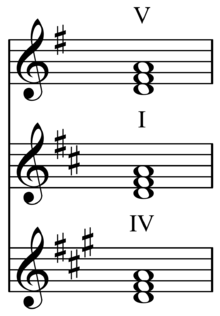
A common chord, in the theory of harmony, is a chord that is diatonic to more than one key or, in other words, is common to (shared by) two keys.[1] A "common chord" may also be defined simply as a triadic chord[2] (e.g., C–E–G), as one of the most commonly used chords in a key (I–IV–V–vi–ii–iii),[3] more narrowly as a triad in which the fifth is perfect (i.e., a major or minor triad), in which sense it is alternatively referred to as a "perfect chord"[4][5] or, more narrowly still (in American practice[6][7]), as a major triad only.[8]
Common chords are frequently used in modulations, in a type of modulation known as common chord modulation or diatonic pivot chord modulation. It moves from the original key to the destination key (usually a closely related key) by way of a chord both keys share. For example, G major and D major have 4 chords in common: G, Bm, D, Em. This can be easily determined by a chart similar to the one below, which compares chord qualities. The I chord in G major—a G major chord—is also the IV chord in D major, so I in G major and IV in D major are aligned on the chart.
| C major: | V | vi | viio | I | ii | iii | IV |
|---|---|---|---|---|---|---|---|
| G major: | I | ii | iii | IV | V | vi | viio |
| D major: | IV | V | vi | viio | I | ii | iii |
Any chord with the same root note and chord quality can be used as the "pivot chord." However, chords that are not generally found in the style of the piece (for example, major VII chords in a Bach-style chorale) are also not likely to be chosen as the pivot chord. The most common pivot chords are the predominant chords (ii and IV) in the new key. When analyzing a piece that uses this style of modulation, the common chord is labeled with its function in both the original and the destination keys, as it can be seen either way.
A chord is common to, or shared by, six keys: three major keys, and three relative minor keys. For example, a C major chord is contained in F, C, and G major as well as D, A, and E minor.
- ^ Bruce Benward and Nadine Saker, Music in Theory and Practice Vol. I (Boston: McGraw Hill, 2003): p. 244. ISBN 978-0-07-294262-0.
- ^ Johnson, A. N. (Artemas Nixon) (1855). Practical instructions in harmony, upon the Pestalozzian or inductive system; teaching musical composition and the art of extemporizing interludes and voluntaries. University of California Libraries. Boston: Oliver Ditson and Company. p. 5.
A common chord is composed of three letters, so arranged that the second letter is at the interval of a third, and the third letter at the interval of a fifth, from the first letter.
- ^ Brad Hill, The Complete Idiot's Guide to Playing Piano (U.S.: Penguin, 2001): pp. 133&135. ISBN 978-0-02-864155-3.
- ^ "chord". Oxford English Dictionary (Online ed.). Oxford University Press. (Subscription or participating institution membership required.), entry "chord, n.2", sense 3.a.
- ^ Michael Kennedy, "Common Chord", The Oxford Dictionary of Music, second edition, revised (Oxford and New York: Oxford University Press, 2006) ISBN 9780198614593.
- ^ Anon. "Common Chord", The Oxford Companion to Music, edited by Alison Latham (Oxford and New York: Oxford University Press, 2002). ISBN 978-0-19-866212-9.
- ^ Anon., "Common Chord", The New Grove Dictionary of Music and Musicians, second edition, edited by Stanley Sadie and John Tyrrell (London: Macmillan Publishers, 2001). ISBN 9780195170672
- ^ Don Michael Randel, "Common Chord", Harvard Dictionary of Music, fourth edition, Harvard University Press Reference Library 16 (Cambridge: Harvard University Press 2003): 193. ISBN 978-0-674-01163-2. "Common chord: Major triad."